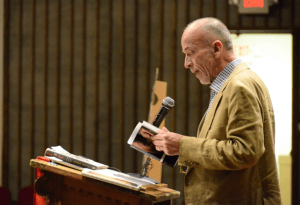Danny Linggonegoro in Nautilus:
 One part of the Hippocratic Oath, the vow taken by physicians, requires us to “remember that there is art to medicine as well as science, and that warmth, sympathy, and understanding may outweigh the surgeon’s knife or the chemist’s drug.” When I, along with my medical school class, recited that oath at my white coat ceremony a year ago, I admit that I was more focused on the biomedical aspects than the “art.” I bought into the mechanism of insulin lowering blood sugar. I bought into the concept of diabetes-induced kidney damage. I bought into the idea of small intestinal bacterial overgrowth in patients with diabetes. But art’s—poetry’s—role in the modern practice of medicine? I’ve changed my mind. Physicians are beginning to understand that the role of language and human expression in medicine extends beyond that horizon of uncertainty where doctor and patient must speak to each other about a course of treatment. The restricted language of blood oxygen levels, drug protocols, and surgical interventions may conspire against understanding between doctor and patient—and against healing. As doctors learn to communicate beyond these restrictions, they are reaching for new tools—like poetry.
One part of the Hippocratic Oath, the vow taken by physicians, requires us to “remember that there is art to medicine as well as science, and that warmth, sympathy, and understanding may outweigh the surgeon’s knife or the chemist’s drug.” When I, along with my medical school class, recited that oath at my white coat ceremony a year ago, I admit that I was more focused on the biomedical aspects than the “art.” I bought into the mechanism of insulin lowering blood sugar. I bought into the concept of diabetes-induced kidney damage. I bought into the idea of small intestinal bacterial overgrowth in patients with diabetes. But art’s—poetry’s—role in the modern practice of medicine? I’ve changed my mind. Physicians are beginning to understand that the role of language and human expression in medicine extends beyond that horizon of uncertainty where doctor and patient must speak to each other about a course of treatment. The restricted language of blood oxygen levels, drug protocols, and surgical interventions may conspire against understanding between doctor and patient—and against healing. As doctors learn to communicate beyond these restrictions, they are reaching for new tools—like poetry.
Researchers have demonstrated with functional magnetic resonance imaging that reciting poetry engages the primary reward circuitry in the brain, called the mesolimbic pathway. So does music—but, the researchers found, poetry elicited a unique response.1 While the mechanism is unclear, it’s been suggested that poetic, musical, and other nonpharmacologic adjuvant therapies can reduce pain and the use and dosage of opioids.2
More here.
